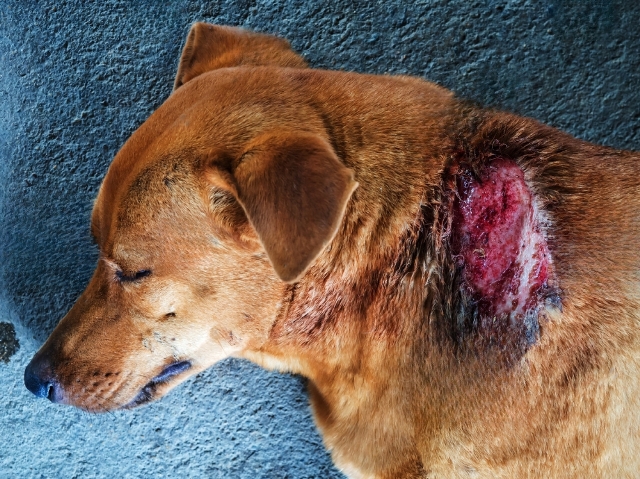Your dog needs immediate medical attention if he has been assaulted or involved in a fight. This article will teach you how to inspect the injury, clean the wound, and determine whether to take your pet to the doctor.
Not all cuts and open wounds sustained by dogs need immediate veterinary attention and there’s no magic bullet for treating dog bite wounds on your pet except the essential first aid treatment. Dog bites may be terrifying, but if you stay calm, know what to look for in an injury assessment, and have a plan, you can help ensure the injured dog gets the care it needs and recovers quickly.
Examining the Effects of a Dog Attack on Another Dog
It is not uncommon for dogs to snipe at one another if they feel that the other dog is being too nasty. This behavior is more likely to occur when the dogs are agitated about something or competing for the same resource. These kinds of little altercations almost seldom result in any harm. But, if your dog is involved in a fight, you should still examine him thoroughly after the incident and search for indicators that he may have been bitten by another dog.
Check the skin below the moist spots caused by his saliva by parting his hair and looking there. In order to do a comprehensive and methodical check on dogs with long or thick coats, a brush or comb may prove to be beneficial. It’s possible that the only injury sustained was a scratch from the other dog’s incisors if the bite was nothing more than a warning nip or if your dog has some evasive abilities (the small rows of teeth at the very front of the mouth).
The skin may be ripped or punctured deeply by the larger canine teeth. Always look for further puncture marks after discovering one, bearing in mind the Dog’s size. Two punctures from the top canine teeth usually spaced about the width of the dog’s snout apart, and a second set, usually on the other side of the dog’s leg or neck, are what you should look out for. This is because the upper canine teeth are the sharpest teeth in the dog’s mouth. The size of the dog, the power of the bite, and the location of the attack are all factors that might affect the depth and number of punctures that are caused by the bite.
In addition to the neck and the legs, the ears and the face are other frequent targets for bite wounds. Even if just a minor nick is caused by the dog bite, the victim’s ears will often bleed significantly after the incident. Bites that occur in parts of your dog’s body that have thicker hair may be more difficult to locate, and you may not realize they have occurred until your dog is able to get calm enough to lick at them or starts to hobble from a leg wound.
There are specific symptoms that need to be evaluated and treated right away in an emergency setting. Among them include uncontrolled bleeding, trouble breathing, weakness, weeping or whining, limping, gums that are pale or blue, collapse, or whimpering.
How To Treat A Dog Bite On A dog At Home
Although I am not a big fan of treating a dog bite at home due to the dangers it poses to both the owner and other people, I would still recommend it in some cases where the injury is very minor or insignificant, and in case of emergency to stop bleeding or various effects that may result from the dog bite.
If you are going to treat a minor dog bite on your own dog at home, make sure that you have someone to assist you and confine your pet while you treat the wound. You may always try using a muzzle if no one else is present. Pain has the potential to make a pet behave in unexpected ways, even if they have never shown violent behavior before. To protect yourself against scratches or bites, devise a strategy to keep your pet steady and quiet while you treat the wound.
Attempt to staunch the bleeding. If the wound is bleeding, place a clean towel or piece of cloth over it and apply some gentle pressure. As this is a more dangerous wound than a simple cut, you should get your pet to the emergency veterinary facility as soon as possible if it is bleeding heavily from the wound.
Make sure the cut is clean. It can seem like a small injury, but puncture wounds, like those caused by a bite, are really rather serious. Infected bite wounds contain germs that may cause infections elsewhere in the body. Clean and bandage the wound, regardless of how little it is. To do this, get a bottle of clean water and pour it into it. Next, spray the wound with water to remove any debris, dirt, or other foreign matter.
Use the tweezers to pick up and remove any foreign things. Tweezers should be used to extract any foreign objects, such as glass, twigs, or thorns that may be lodged in the wound. To clear away all of the debris, you should make use of a magnifying glass.
Clean and disinfect the wound. Clean the damaged area carefully with a cleaner such as diluted betadine or chlorhexidine, both of which are often included in pre-packaged first aid kits. It is important not to use rubbing alcohol or hydrogen peroxide since any of these substances might cause harm to the tissue and slow down the healing process.
Dress the wound by covering it with a bandage. After applying the tiniest quantity of antibacterial ointment to the wound, wrap it with a piece of sterile gauze or another kind of bandage. Make use of elastic tape in order to secure the bandage in place.
Note: Consider using an electronic collar. Animals as pets are unable to comprehend the concept of not biting or licking at a bandage. Since their mouths may introduce germs into the wound, which will need you to continuously clean the area and reapply a bandage, you might think about employing an E-collar (also known as a cone of shame) to cover the wound site.
When To Call Your Doctor to Treat The Dog Bite Wound on Your Dog
Even though you can provide first aid for a dog bite at home, it is extremely important to visit a doctor. This is especially the case if your dog was bitten by a strange dog, if the bite was particularly severe, if you were unable to stop the bleeding, or if there were any indications that an infection was present (redness, swelling, warmth, pus).
Your dog’s overall health, the number of wounds, and the location of the wounds will all be taken into consideration when determining the appropriate course of treatment by your veterinarian. The severity of any infection that may develop should ideally be lessened as a result of the therapy. The wounds will be cleaned, any dead or badly damaged tissue will be removed, and the wounds may be closed surgically if necessary. This will bring about the desired result.
Antibiotics may be administered for wounds that have pierced the skin. The prescription will depend on the location of the wound as well as the amount of time that has passed since the bite occurred and the time that the patient was brought to the veterinarian. Your veterinarian may recommend a topical antibiotic for the treatment of small wounds or for wounds that must be left exposed in order to heal properly.
Since most wounds are unpleasant, it is more humane to provide pain medicine, a sedative, or anesthesia to your dog before trying to evaluate the severity of the injury. The hair will next be shaved off the skin that surrounds the wounds in order to reduce the risk of further contamination. Your veterinarian will then flush the wounds in order to eliminate any pollutants and debris that may be present.
It is recommended by professionals that bacterial culture and sensitivity tests be carried out in order to ascertain the kind of bacteria that is present as well as the antibiotics that are most effective in treating these germs. Since the results of the tests take a few days to be available, your veterinarian may not undertake these tests unless the wounds on your pet do not react correctly to the first treatment with broad-spectrum antibiotics.
What can I do to protect my dog from being bitten by other dogs?
While you are outside, do not let your dog run at liberty, and keep your dog on a short, tight leash at all times, but this is particularly important when you are at a park. It is highly suggested that basic obedience training begin as early as possible in the life of a dog since well-mannered dogs are less prone to engage in aggressive behavior.
Do not approach a wandering stray dog if you are outside with your own dog and you notice it. Stray dogs may be dangerous. You have no way of knowing the temperament of the other dog, even if the one you have is calm and friendly, and your dog may be perfectly fine with it. It is important to take preventive measures, such as ensuring that the rabies vaccination that your pet receives is always up to date.

